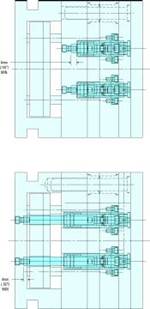Rotating Stack Mold Technology Offers Multi-Shot Capability, High-Volume Production
A turning stack mold technology has been developed to meet the rigors of in-mold labeling (IML) production needs that combines high-volume production with multi-shot capability.
A turning stack mold technology has been developed to meet the rigors of in-mold labeling (IML) production needs that combines high-volume production with multi-shot capability.
Moldmaker Foboha’s (Haslach, Germany) patented turning stack mold—developed with Ferromatik (Malterdingen, Germany), rotates horizontally in 90-degree increments. At each turn, a different operation (label insert, molding, part cooling, demolding) occurs. This results in a less complicated operation that meets IML production needs.
According to Foboha U.S. Sales Engineer Lisa Mauro, with this technology, labels are applied to the rear of the cube after the mold clamps shut on the opposite side to form parts. Therefore, a robot can take the full molding cycle to insert labels—rather than doing it in a fraction of the time as with conventional molds. “I believe the cube molds are advantageous for IML because the complexity of automation is minimized,” she notes.
How It Works
The turning stack mold has a center cube that indexes in 90-degree increments—allowing the non-molding sides to be used for cooling or inserting. A hydraulic or servo motor indexes the center section in 1.3 seconds with a programmable acceleration/deceleration profile. Additionally, the system has three parting lines that allow one injection molding machine to mold two precision parts from two materials, label and assemble finished product. By mounting a secondary injection unit at a 45-degree angle on top of the moving platen, the machine saves floor space. “Cycle time is then reduced, because the injection nozzle stays mated to the sprue bushing during clamp movement,” Mauro points out.
In contrast to conventional injection molding in multicomponent technology, the injection molded parts produced using this technology are processed at different levels within the turning system, Mauro adds. “Parts can therefore be molded at both levels in the same production stage, and the parts already finished ejected in the free station. The next rotation (2 x 180° or 4 x 90°) feeds the new pre-molding parts to the processing station that has been vacated.”
This system runs only on modified injection molding machines. These units feature a standardized option package for the stack mold technology that provides longer tiebars, which increases shut height and a more robust machine bed to support the turning center section. The second injection unit is positioned beside the turntable, perpendicular to the machine.
Advantages/Applications
Mauro notes that there are numerous advantages to using this system. “Highly complex parts can be manufactured on a single machine, the clamping force of the machine can be halved, the number of cavities can be doubled, and production cycles are significantly shorter.” She adds that this system also lends itself to a number of unusual applications, including thermoplastic/thermoset (“hot/cold”) molding, where one material needs a hot mold to cure and the other needs a cold mold.
“Our stack turning technology is setting new standards,” Mauro concludes. “Cycle times can be reduced by up to 25 percent and cavity numbers doubled with the same machine size.”
Related Content
-
Laser Welding Versus Micro Welding
The latest battle in finely detailed restoration/repair of mold materials.
-
It Starts With the Part: A Plastic Part Checklist Ensures Good Mold Design
All successful mold build projects start with examining the part to be molded to ensure it is moldable and will meet the customers' production objectives.
-
Treatment and Disposal of Used Metalworking Fluids
With greater emphasis on fluid longevity and fluid recycling, it is important to remember that water-based metalworking fluids are “consumable” and have a finite life.














